- Home
- Neal Stephenson
In the Beginning...Was the Command Line Page 4
In the Beginning...Was the Command Line Read online
Page 4
There are only two ways to sell a product: price and features. When OSes are free, OS companies cannot compete on price, and so they compete on features. This means that they are always trying to outdo each other writing code that, until recently, was not considered to be part of an OS at all: stuff like GUIs. This explains a lot about how these companies behave.
It explains why Microsoft added a browser to their OS, for example. It is easy to get free browsers, just as to get free OSes. If browsers are free, and OSes are free, it would seem that there is no way to make money from browsers or OSes. But if you can integrate a browser into the OS and thereby imbue both of them with new features, you have a salable product.
Setting aside, for the moment, the fact that this makes government antitrust lawyers really mad, this strategy makes sense. At least, it makes sense if you assume (as Microsoft’s management appears to) that the OS has to be protected at all costs. The real question is whether every new technological trend that comes down the pike ought to be used as a crutch to maintain the OS’s dominant position. Confronted with the web phenomenon, Microsoft had to develop a really good web browser, and they did. But then they had a choice: they could have made that browser work on many different OSes, which would give Microsoft a strong position in the Internet world no matter what happened to their OS market share. Or they could make the browser appear to be one with the OS, gambling that this would make the OS look so modern and sexy that it would help to preserve their dominance in that market. The problem is that when Microsoft’s OS position begins to erode (and since it is currently at something like ninety percent, it can’t go anywhere but down) it will drag everything else down with it.
In your high school geology class you probably were taught that all life on earth exists in a paper-thin shell called the biosphere, which is trapped between thousands of miles of dead rock underfoot, and cold dead radioactive empty space above. Companies that sell OSes exist in a sort of technosphere. Underneath is technology that has already become free. Above is technology that has yet to be developed, or that is too crazy and speculative to be productized just yet. Like the earth’s biosphere, the technosphere is very thin compared to what is above and what is below.
But it moves a lot faster. In various parts of our world, it is possible to go and visit rich fossil beds where skeleton lies piled upon skeleton, recent ones on top and more ancient ones below. In theory they go all the way back to the first single-celled organisms. And if you use your imagination a bit, you can understand that, if you hang around long enough, you’ll become fossilized there too, and in time some more advanced organism will become fossilized on top of you.
The fossil record—the La Brea Tar Pit—of software technology is the Internet. Anything that shows up there is free for the taking (possibly illegal, but free). Executives at companies like Microsoft must get used to the experience—unthinkable in other industries—of throwing millions of dollars into the development of new technologies, such as web browsers, and then seeing the same or equivalent software show up on the Internet for free two years, or a year, or even just a few months, later.
By continuing to develop new technologies and add features onto their products, they can keep one step ahead of the fossilization process, but on certain days they must feel like mammoths caught at La Brea, using all their energies to pull their feet, over and over again, out of the sucking hot tar that wants to cover and envelop them.
Survival in this biosphere demands sharp tusks and heavy, stomping feet at one end of the organization, and Microsoft famously has those. But trampling the other mammoths into the tar can only keep you alive for so long. The danger is that in their obsession with staying out of the fossil beds, these companies will forget about what lies above: the realm of new technology. In other words, they must hang on to their primitive weapons and crude competitive instincts, but also evolve powerful brains. This appears to be what Microsoft is doing with its research division, which has been hiring smart people right and left. (Here I should mention that although I know, and socialize with, several people in that company’s research division, we never talk about business issues and I have little to no idea what the hell they are up to. I have learned much more about Microsoft by using the Linux operating system than I ever would have done by using Windows.)
Never mind how Microsoft used to make money; today, it is making its money on a kind of temporal arbitrage. “Arbitrage,” in the usual sense, means to make money by taking advantage of differences in the price of something between different markets. It is spatial, in other words, and hinges on the arbitrageur knowing what is going on simultaneously in different places. Microsoft is making money by taking advantage of differences in the price of technology in different times. Temporal arbitrage, if I may coin a phrase, hinges on the arbitrageur knowing what technologies people will pay money for next year, and how soon afterwards those same technologies will become free. What spatial and temporal arbitrage have in common is that both hinge on the arbitrageur’s being extremely well informed: one about price gradients across space at a given time, and the other about price gradients over time in a given place.
So Apple and Microsoft shower new features upon their users almost daily, in the hopes that a steady stream of genuine technical innovations, combined with the “I want to believe” phenomenon, will prevent their customers from looking across the road toward the cheaper and better OSes that are available to them. The question is whether this makes sense in the long run. If Microsoft is addicted to OSes as Apple is to hardware, then they will bet the whole farm on their OSes and tie all of their new applications and technologies to them. Their continued survival will then depend on these two things: adding more features to their OSes so that customers will not switch to the cheaper alternatives, and maintaining the image that, in some mysterious way, gives those customers the feeling that they are getting something for their money.
The latter is a truly strange and interesting cultural phenomenon.
THE INTERFACE CULTURE *
A few years ago I walked into a grocery store somewhere and was presented with the following tableau vivant: near the entrance a young couple were standing in front of a large cosmetics display. The man was stolidly holding a shopping basket between his hands while his mate raked blister-packs of makeup off the display and piled them in. Since then I’ve always thought of that man as the personification of an interesting human tendency: not only are we not offended to be dazzled by manufactured images, but we like it. We practically insist on it. We are eager to be complicit in our own dazzlement: to pay money for a theme park ride, vote for a guy who’s obviously lying to us, or stand there holding the basket as it’s filled up with cosmetics.
I was in Disney World recently, specifically the part of it called the Magic Kingdom, walking up Main Street USA. This is a perfect gingerbready Victorian small town that culminates in a Disney castle. It was very crowded; we shuffled rather than walked. Directly in front of me was a man with a camcorder. It was one of the new breed of camcorders where instead of peering through a viewfinder you gaze at a flat-panel color screen about the size of a playing card, which televises live coverage of whatever the camcorder is seeing. He was holding the appliance close to his face, so that it obstructed his view. Rather than go see a real small town for free, he had paid money to see a pretend one, and rather than see it with the naked eye, he was watching it on television.
And rather than stay home and read a book, I was watching him.
Americans’ preference for mediated experiences is obvious enough, and I’m not going to keep pounding it into the ground. I’m not even going to make snotty comments about it—after all, I was at Disney World as a paying customer. But it clearly relates to the colossal success of GUIs, and so I have to talk about it some. Disney does mediated experiences better than anyone. If they understood what OSes are, and why people use them, they could crush Microsoft in a year or two.
In the part of Disney World ca
lled the Animal Kingdom there is a new attraction called the Maharajah Jungle Trek. It was open for sneak previews when I was there. This is a complete stone-by-stone reproduction of a hypothetical ruin in the jungles of India. According to its backstory, it was built by a local rajah in the sixteenth century as a game reserve. He would go there with his princely guests to hunt Bengal tigers. As time went on, it fell into disrepair and the tigers and monkeys took it over; eventually, around the time of India’s independence, it became a government wildlife reserve, now open to visitors.
The place looks more like what I have just described than any actual building you might find in India. All the stones in the broken walls are weathered as if monsoon rains had been trickling down them for centuries, the paint on the gorgeous murals is flaked and faded just so, and Bengal tigers loll amid stumps of broken columns. Where modern repairs have been made to the ancient structure, they’ve been done, not as Disney’s engineers would do them, but as thrifty Indian janitors would—with hunks of bamboo and rust-spotted hunks of rebar. The rust is painted on, of course, and protected from real rust by a plastic clear-coat, but you can’t tell unless you get down on your knees.
In one place you walk along a stone wall with a series of old pitted friezes carved into it. One end of the wall has broken off and settled into the earth, perhaps because of some long-forgotten earthquake, and so a broad jagged crack runs across a panel or two, but the story is still readable: first, primordial chaos leads to a flourishing of many animal species. Next, we see the Tree of Life surrounded by diverse animals. This is an obvious allusion (or, in showbiz lingo, a tie-in) to the gigantic Tree of Life that dominates the center of Disney’s Animal Kingdom just as the Castle dominates the Magic Kingdom or the Sphere does Epcot. But it’s rendered in historically correct style and could probably fool anyone who didn’t have a Ph.D. in Indian art history.
The next panel shows a mustachioed H. sapiens chopping down the Tree of Life with a scimitar, and the animals fleeing every which way. The one after that shows the misguided human getting walloped by a tidal wave, part of a latter-day Deluge presumably brought on by his stupidity.
The final panel, then, portrays the Sapling of Life beginning to grow back, but now Man has ditched the edged weapon and joined the other animals in standing around to adore and praise it.
It is, in other words, a prophecy of the Bottleneck: the scenario, commonly espoused among modern-day environmentalists, that the world faces an upcoming period of grave ecological tribulations that will last for a few decades or centuries and end when we find a new harmonious modus vivendi with Nature.
Taken as a whole the frieze is a pretty brilliant piece of work. Obviously it’s not an ancient Indian ruin, and some person or people now living deserve credit for it. But there are no signatures on the Maharajah’s game reserve at Disney World. There are no signatures on anything, because it would ruin the whole effect to have long strings of production credits dangling from every custom-worn brick, as they do from Hollywood movies.
Among Hollywood writers, Disney has the reputation of being a real wicked stepmother. It’s not hard to see why. Disney is in the business of putting out a product of seamless illusion—a magic mirror that reflects the world back better than it really is. But a writer is literally talking to his or her readers, not just creating an ambience or presenting them with something to look at. Just as the command line interface opens a much more direct and explicit channel from user to machine than the GUI, so it is with words, writer, and reader.
The word, in the end, is the only system of encoding thoughts—the only medium—that is not fungible, that refuses to dissolve in the devouring torrent of electronic media. (The richer tourists at Disney World wear t-shirts printed with the names of famous designers, because designs themselves can be bootlegged easily and with impunity. The only way to make clothing that cannot be legally bootlegged is to print copyrighted and trademarked words on it; once you have taken that step, the clothing itself doesn’t really matter, and so a t-shirt is as good as anything else. T-shirts with expensive words on them are now the insignia of the upper class. T-shirts with cheap words, or no words at all, are for the commoners.)
But this special quality of words and of written communication would have the same effect on Disney’s product as spray-painted graffiti on a magic mirror. So Disney does most of its communication without resorting to words, and for the most part, the words aren’t missed. Some of Disney’s older properties, such as Peter Pan, Winnie the Pooh, and Alice in Wonderland, came out of books. But the authors’ names are rarely if ever mentioned, and you can’t buy the original books at the Disney store. If you could, they would all seem old and queer, like very bad knockoffs of the purer, more authentic Disney versions. Compared to more recent productions like Beauty and the Beast and Mulan, the Disney movies based on these books (particularly Alice in Wonderland and Peter Pan) seem deeply bizarre, and not wholly appropriate for children. That stands to reason, because Lewis Carroll and J. M. Barrie were very strange men, and such is the nature of the written word that their personal strangeness shines straight through all the layers of Disneyfication like X-rays through a wall. Probably for this very reason, Disney seems to have stopped buying rights to books altogether, and now finds its themes and characters in folk tales, which have the lapidary, timeworn quality of the ancient bricks in the Maharajah’s ruins.
If I can risk a broad generalization, most of the people who go to Disney World have zero interest in absorbing new ideas from books. This sounds snide, but listen: they have no qualms about being presented with ideas in other forms. Disney World is stuffed with environmental messages now, and the guides at Animal Kingdom can talk your ear off about biology.
If you followed those tourists home, you might find art, but it would be the sort of unsigned folk art that’s for sale in Disney World’s African- and Asian-themed stores. In general they only seem comfortable with media that have been ratified by great age, massive popular acceptance, or both. In this world, artists are like the anonymous, illiterate stone carvers who built the great cathedrals of Europe and then faded away into unmarked graves in the churchyard. The cathedral as a whole is awesome and stirring in spite, and possibly because, of the fact that we have no idea who built it. When we walk through it, we are communing not with individual stone carvers but with an entire culture.
Disney World works the same way. If you are an intellectual type, a reader or writer of books, the nicest thing you can say about this is that the execution is superb. But it’s easy to find the whole environment a little creepy, because something is missing: the translation of all its content into clear explicit written words, the attribution of the ideas to specific people. You can’t argue with it. It seems as if a hell of a lot might be being glossed over, as if Disney World might be putting one over on us, and possibly getting away with all kinds of buried assumptions and muddled thinking.
And this is precisely the same as what is lost in the transition from the command line interface to the GUI.
Disney and Apple/Microsoft are in the same business: short-circuiting laborious, explicit verbal communication with expensively designed interfaces. Disney is a sort of user interface unto itself—and more than just graphical. Let’s call it a Sensorial Interface. It can be applied to anything in the world, real or imagined, albeit at staggering expense.
Why are we rejecting explicit word-based interfaces, and embracing graphical or sensorial ones—a trend that accounts for the success of both Microsoft and Disney?
Part of it is simply that the world is very complicated now—much more complicated than the hunter-gatherer world that our brains evolved to cope with—and we simply can’t handle all of the details. We have to delegate. We have no choice but to trust some nameless artist at Disney or programmer at Apple or Microsoft to make a few choices for us, close off some options, and give us a conveniently packaged executive summary.
But more importantly, it comes out of the fac
t that during this century, intellectualism failed, and everyone knows it. In places like Russia and Germany, the common people agreed to loosen their grip on traditional folkways, mores, and religion, and let the intellectuals run with the ball, and they screwed everything up and turned the century into an abattoir. Those wordy intellectuals used to be merely tedious; now they seem kind of dangerous as well.
We Americans are the only ones who didn’t get creamed at some point during all of this. We are free and prosperous because we have inherited political and value systems fabricated by a particular set of eighteenth-century intellectuals who happened to get it right. But we have lost touch with those intellectuals, and with anything like intellectualism, even to the point of not reading books anymore, though we are literate. We seem much more comfortable with propagating those values to future generations non-verbally, through a process of being steeped in media. Apparently this actually works to some degree, for police in many lands are now complaining that local arrestees are insisting on having their Miranda rights read to them, just like perps in American TV cop shows. When it’s explained to them that they are in a different country, where those rights do not exist, they become outraged. Starsky and Hutch reruns, dubbed into diverse languages, may turn out, in the long run, to be a greater force for human rights than the Declaration of Independence.
The written word is unique among media in that it is a digital medium that humans can, nonetheless, easily read and write. Humans are conversant in many media (music, dance, painting), but all of them are analog except for the written word, which is naturally expressed in digital form (i.e. it is a series of discrete symbols—every letter in every book is a member of a certain character set, every “a” is the same as every other “a,” and so on). As any communications engineer can tell you, digital signals are much better to work with than analog ones because they are easily copied, transmitted, and error-checked. Unlike analog signals, they are not doomed to degradation over time and distance. That is why digital compact disks replaced analog LPs, for example. The digital nature of the written word confers on it exceptional stability, which is why it is the vehicle of choice for extremely important concepts like the Ten Commandments, the Koran, and the Bill of Rights. This is generally thought to be a rather good idea. But the messages conveyed by modern audiovisual media cannot be pegged to any fixed, written set of precepts in that way and consequently they are free to wander all over the place and possibly dump loads of crap into people’s minds.

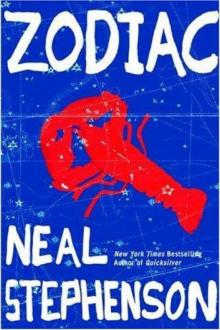 Zodiac: The Eco-Thriller
Zodiac: The Eco-Thriller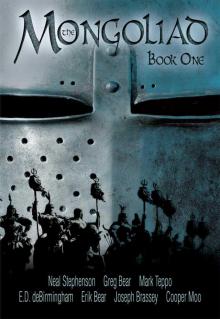 The Mongoliad: Book One
The Mongoliad: Book One Snow Crash
Snow Crash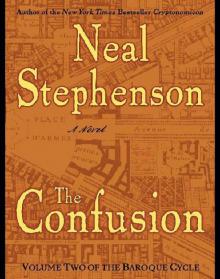 The Confusion: Volume Two of the Baroque Cycle
The Confusion: Volume Two of the Baroque Cycle The Rise and Fall of D.O.D.O.
The Rise and Fall of D.O.D.O.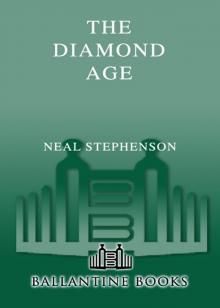 The Diamond Age: Or, a Young Lady's Illustrated Primer
The Diamond Age: Or, a Young Lady's Illustrated Primer The Big U
The Big U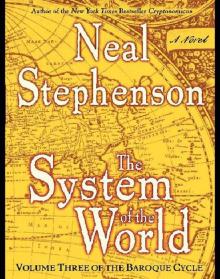 The System of the World: Volume Three of the Baroque Cycle
The System of the World: Volume Three of the Baroque Cycle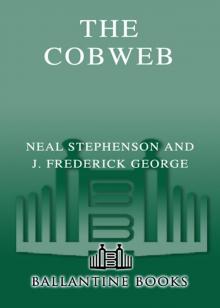 The Cobweb
The Cobweb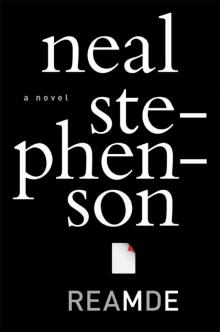 Reamde
Reamde Fall; or, Dodge in Hell
Fall; or, Dodge in Hell Interface
Interface Quicksilver
Quicksilver The Mongoliad: Book Three
The Mongoliad: Book Three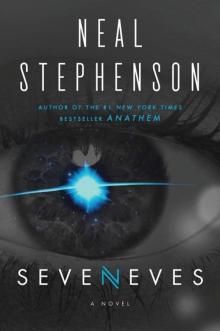 Seveneves
Seveneves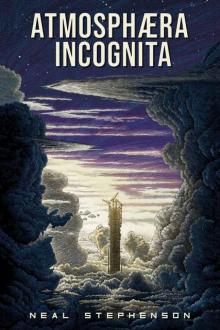 Atmosphæra Incognita
Atmosphæra Incognita In the Beginning...Was the Command Line
In the Beginning...Was the Command Line Anathem
Anathem The Rise and Fall of D.O.D.O.: A Novel
The Rise and Fall of D.O.D.O.: A Novel The Mongoliad: Book Two
The Mongoliad: Book Two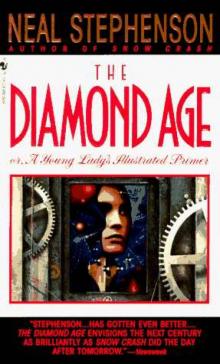 Diamond Age or a Young Lady's Illustrated Primer
Diamond Age or a Young Lady's Illustrated Primer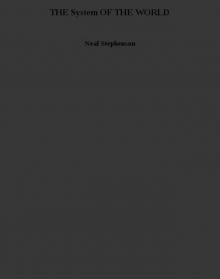 THE System OF THE WORLD
THE System OF THE WORLD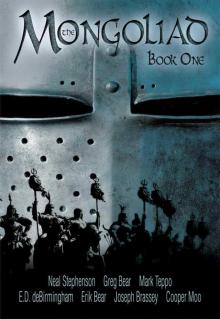 The Mongoliad: Book One tfs-1
The Mongoliad: Book One tfs-1 Some Remarks: Essays and Other Writing
Some Remarks: Essays and Other Writing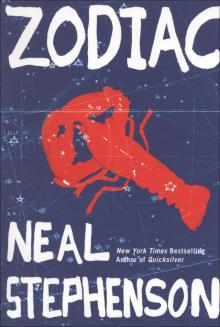 Zodiac
Zodiac Spew
Spew The Baroque Cycle: Quicksilver, the Confusion, and the System of the World
The Baroque Cycle: Quicksilver, the Confusion, and the System of the World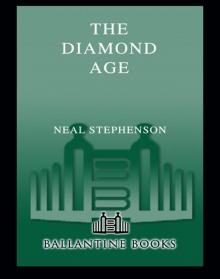 The Diamond Age
The Diamond Age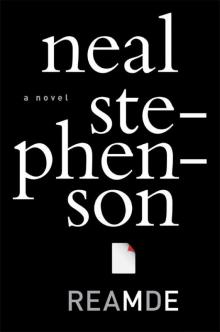 Reamde: A Novel
Reamde: A Novel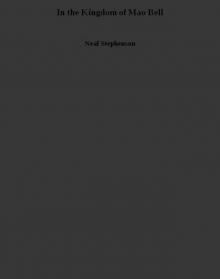 In the Kingdom of Mao Bell
In the Kingdom of Mao Bell Mother Earth Mother Board
Mother Earth Mother Board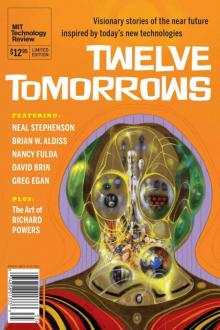 Twelve Tomorrows - Visionary stories of the near future inspired by today's technologies
Twelve Tomorrows - Visionary stories of the near future inspired by today's technologies The Confusion
The Confusion The Great Simoleon Caper
The Great Simoleon Caper The Mongoliad: Book Three tfs-3
The Mongoliad: Book Three tfs-3